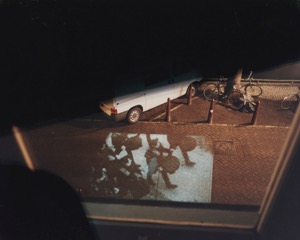“It puts you in the position of looking out, from being in hiding,” Attie explains. The project probes, in its oblique way, the reputation of the Dutch as heroic shelterers of the Jews, based largely on the iconic power of the Anne Frank story. In fact, Attie points out, nearly 80% of Amsterdam’s Jews–all “neighbors next door”–were deported and killed, betrayed.
For this 1995 project staged in Amsterdam, Shimon Attie mounted projectors in the windows of homes that sheltered Jews during the war, and projected onto the street below archival footage of German soldiers, passing funerals and military bands. The project is only visible in the current exhibition through slits in a wall.
Artists who address issues of the Holocaust face a subject so daunting and immense that it can easily dwarf any effort to comment on it or interpret it. Attie treads lightly, resists any presumptuous attempts at closure, and personalizes the loss without undue melodrama. “I don’t work in a didactic way,” he says. “I want people to draw their own conclusions.”
(Source: Leah Ollman for the LA Times, 2000)
As art critic James E. Young wrote, the images forced the Dutch passersby to confront the national myth of how the Dutch sheltered Jews, and to immerse themselves in the hidden Jews’ memory and see the outside world from their perspective.
-
Read more »By superimposing prewar images on modern sites, Shimon Attie attempts to capture a haunting time.



